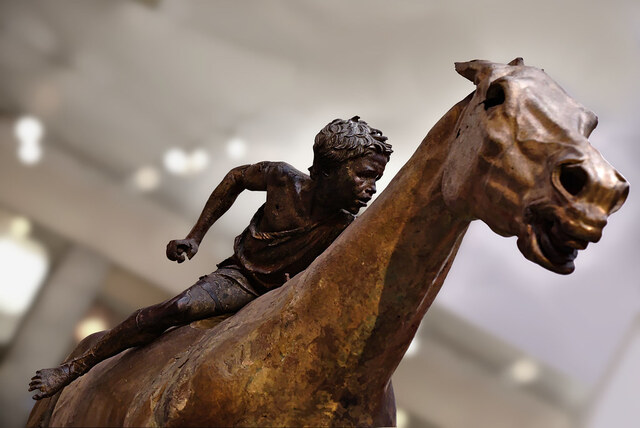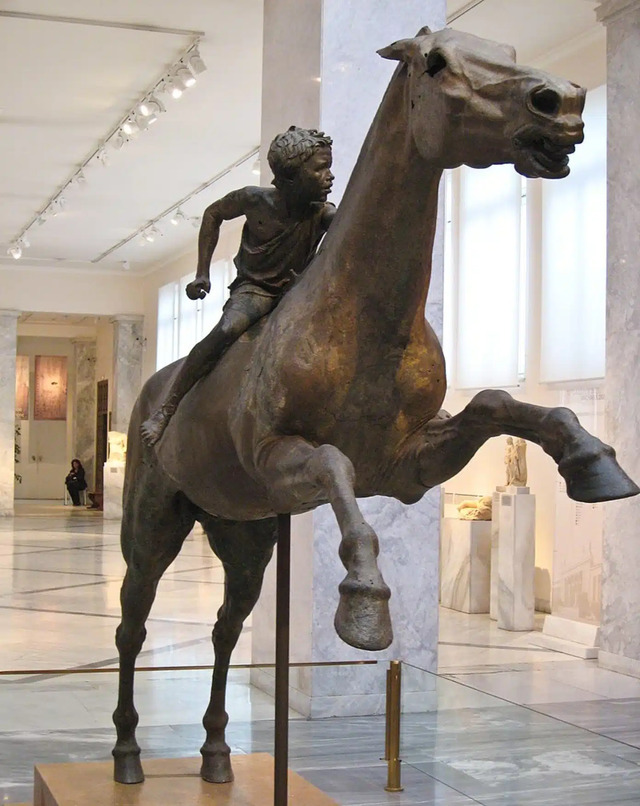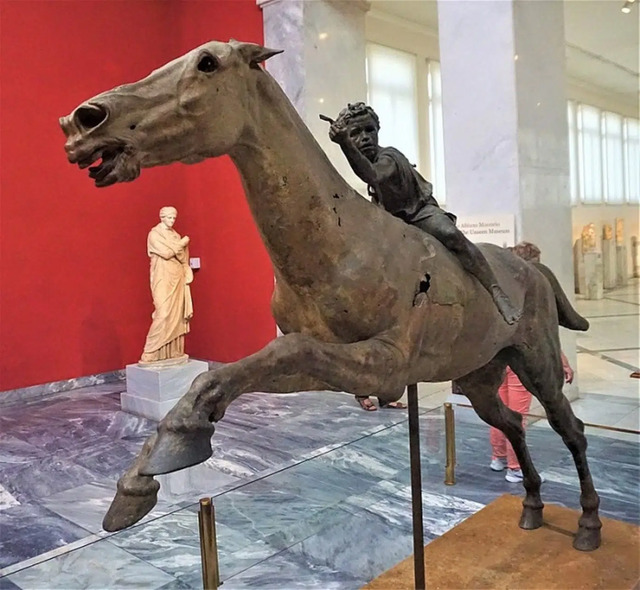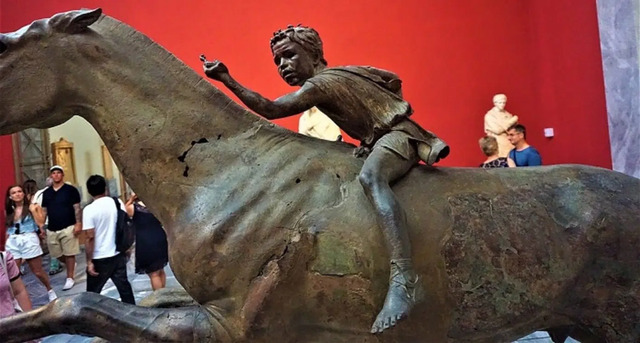The Jockey of Artemision is a remarkable bronze sculpture that embodies the artistic brilliance of Ancient Greece. Discovered in 1928 off the coast of Cape Artemision in northern Euboea, this statue represents a powerful moment frozen in time, depicting a young boy astride a racehorse. It is a rare example of both the high level of craftsmanship and the ability of Greek artists to capture emotion, energy, and movement through sculpture. This statue, one of the few surviving bronze works from the ancient world, offers invaluable insights into the classical ideals of Greek artistry while showcasing the beauty and skill of Hellenistic sculpture.
The Discovery of the Jockey of Artemision
The discovery of the Jockey of Artemision is as fascinating as the sculpture itself. In the fall of 1928, the fragmented pieces of this bronze statue were recovered from a sunken ship near Cape Artemision, an area known for its rich historical significance. Archaeologists found a set of fragments, including parts of a horse, a boy, and an image of a god, which were later restored and reassembled into one stunning work of art. The discovery of this ancient piece, amidst the vast expanse of the Mediterranean Sea, captivated scholars and artists alike, as few sculptures of such historical and artistic importance had survived from the ancient Greek world.
The Dynamic Composition: A Horse and Rider in Motion
One of the most striking features of the Jockey of Artemision is its dynamic composition. The statue vividly captures the intense motion of a horse galloping at full speed, with two of its legs lifted high off the ground, creating a powerful sense of momentum. The horse’s wide eyes, flattened ears, and exaggerated veins vividly convey the strain it experiences while running. Its nostrils flare, mouth open, and tongue lolling as it charges forward, almost panting with exertion.

The rider, a young boy, sits astride the horse with his body leaning toward its neck, as if to counterbalance the wild movement of the animal. His exhaustion is reflected in his open mouth and slack posture. He grips a fragment of the reins with one hand, while the other is positioned as if it were holding a whip or crop. The drapery of his clothing and the fluttering locks of his hair in the wind amplify the energy of the piece, reinforcing the idea that this moment is charged with both physical and emotional intensity.
Video
Watch the video Jockey of Artemision to explore this historical masterpiece.
Greek Classical Ideals: The Blend of Tradition and Expression
The Jockey of Artemision is a powerful fusion of Greek classical ideals and the emotional expression typical of Hellenistic sculpture. While Greek artists of the classical period often focused on achieving idealized forms of beauty, Hellenistic artists began to explore more dramatic and expressive elements in their work. This statue exemplifies that shift by blending the perfected balance of classical forms with heightened drama and emotion.

The juxtaposition of the horse’s powerful, almost exaggerated movement with the calm yet strained posture of the rider reflects a tension that adds depth to the piece. In many ways, this combination of balanced proportions and energetic movement encapsulates the hallmark of Hellenistic sculpture, where classical ideals were not just upheld but were infused with a sense of real-life experience, emotion, and energy. The bronze, with its metallic sheen, beautifully conveys this mixture of idealism and realism, as the figures seem to glisten with sweat, caught in a moment of peak intensity.
Craftsmanship and Materials: Bronze as an Expressive Medium
The Jockey of Artemision is not only a marvel of artistic expression but also of technical craftsmanship. The use of bronze allowed the artist to achieve a level of detail and fluidity that would have been difficult to achieve with other materials. The metallic sheen of the figures gives the statue an almost lifelike quality, capturing the reflections of light in ways that add to the illusion of movement.
The artist’s skill in manipulating bronze to depict the subtle textures of skin, the muscles of the horse, and the drapery of the rider’s clothing speaks volumes about the level of expertise in Greek sculptural practice. The smooth finish and intricate detailing of the horse’s veins and the boy’s facial expressions highlight the importance of craftsmanship in conveying both physical motion and emotional intensity.

The Statue’s History: From Shipwreck to Preservation
Like many works of art from antiquity, the Jockey of Artemision was almost lost to history. Most ancient Greek bronzes were melted down for their valuable materials over the centuries, making this piece one of the rare survivors of its kind. However, its accidental preservation came about when the statue was lost at sea in a shipwreck, preventing it from being destroyed in the usual manner.
Once discovered, it became an invaluable addition to the study of ancient Greek art. It was restored carefully, with its original form pieced together from the fragments retrieved from the shipwreck. The restoration process not only brought back a significant work of art but also provided modern scholars with the opportunity to study the intricacies of ancient Greek sculpture, which had largely been lost due to the destruction of similar pieces over time.
The Mysterious Artist: Speculations on Origins
Despite its iconic status, the identity of the artist who created the Jockey of Artemision remains a mystery. Some scholars suggest that the sculpture might have been plundered from Corinth during the Achaean War of 146 BC by the Roman general Mummius and was possibly given to Attalus, the ruler of Pergamon, before being lost during transit. While the artist’s identity is unknown, the skill and artistry demonstrated in this work have led scholars to speculate that it was created by a master sculptor of the Hellenistic period, a time when Greek art was marked by dramatic expression and technical mastery.
The missing parts of the statue, including the rider’s whip and reins, as well as the horse’s bridle, only add to the intrigue surrounding its creation. These gaps provide an opportunity for researchers to further investigate the original context and purpose of the statue, as well as the artistic conventions that guided its creation.
The Symbolism of Missing Elements and Engraved Imagery
The missing parts of the Jockey of Artemision have sparked much discussion about its original meaning and significance. While the statue is incomplete, the horse and boy together still convey a powerful narrative, one that is rich in symbolism. The engraved image of the goddess Nike, holding a wreath in her raised hands, is located on the horse’s right thigh. This imagery suggests that the statue may have originally been part of a larger composition, possibly associated with victory or competition, further enhancing the dramatic tension of the scene.
The missing reins and whip may have once added further detail to the scene, illustrating the control and command the rider had over the horse, but their absence invites the viewer to focus on the expressive power of the figures themselves. The symbolism of victory and the tension between the horse and rider remains clear, even in the absence of these elements.
Cultural Interpretation: The Mixed Heritage of the Jockey

The Jockey of Artemision is not only a beautiful work of art but also an intriguing cultural artifact. The physiognomy of the boy, who is only about 84 centimeters tall and appears to be around ten years old, has led some scholars to suggest that he may have had African heritage. His facial features and the original black patinated surface coloring of the sculpture imply a possible mixed racial background. However, his hairstyle, which is distinctly Greek, suggests a blending of different cultural influences, reflecting the diverse nature of ancient Greek society during the Hellenistic period.
This mixed heritage interpretation opens up discussions about the multicultural nature of ancient Greece, especially during the Hellenistic era when Greek influence spread far beyond the Aegean. The statue thus serves as a reminder of the complex cultural dynamics at play during this period of Greek history.
Conclusion: A Timeless Masterpiece
The Jockey of Artemision is a breathtaking example of ancient Greek artistry that continues to captivate audiences and scholars alike. Its discovery, craftsmanship, and rich symbolism provide invaluable insight into the artistic achievements of ancient Greece, particularly during the Hellenistic period. Whether it is the drama and energy captured in the horse’s movement or the blending of classical ideals with emotional expression, the Jockey of Artemision stands as a testament to the genius of Greek sculptors and their ability to bring both form and feeling to life. As a rare survivor from the ancient world, it offers a glimpse into the past, allowing us to appreciate the beauty, complexity, and timeless nature of Greek art.
Video
Watch the video to see a sculptor recreate Antonio Canova’s “Venus” step-by-step, from clay to marble, in a time-lapse.



